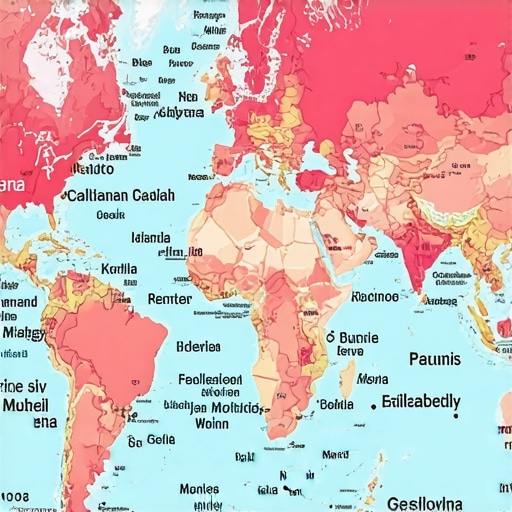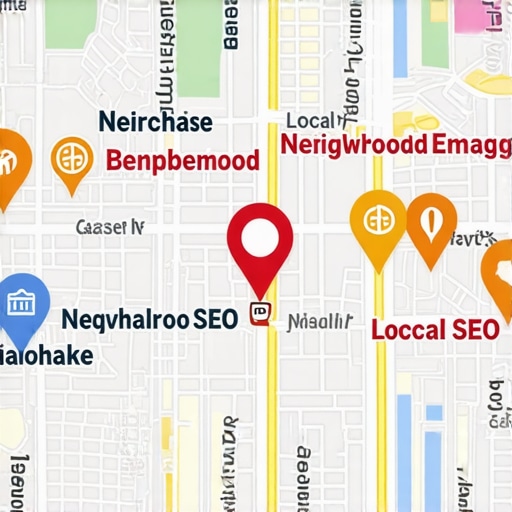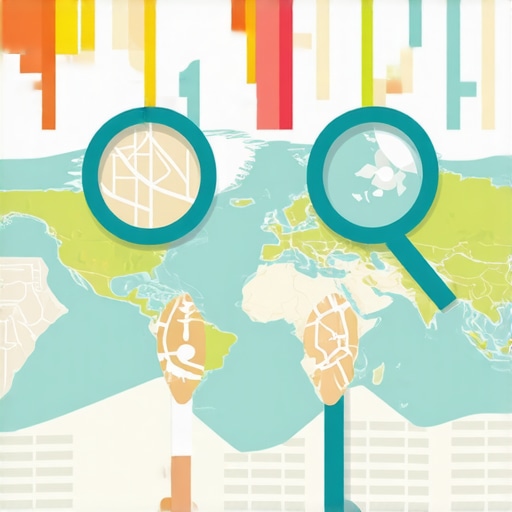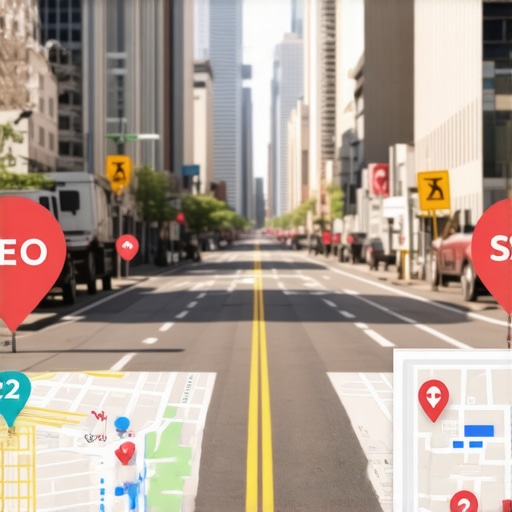Unlocking the Power of Maps SEO: A Strategic Perspective for 2024
As digital landscapes evolve, local search optimization, particularly through Maps SEO, has become a critical component of comprehensive online visibility strategies. In 2024, mastering the nuances of map-based search algorithms is not merely advantageous but essential for businesses aiming to dominate local markets. This article explores sophisticated strategies rooted in industry insights, advanced keyword integration, and technical optimization to enhance your Google Maps ranking.
Decoding Google’s Local Algorithm: A Deep Dive into Map Ranking Factors
Understanding Google’s local ranking factors is foundational. These include proximity, relevance, and prominence. However, recent updates have emphasized user engagement metrics—such as review quality, update frequency, and interaction signals—that influence map visibility. Leveraging these factors requires a nuanced approach that combines technical SEO with reputation management, ensuring your business remains a top contender in local searches.
Semantic SEO and Niche-Specific Optimization for Map Listings
Semantic SEO, involving the strategic use of Latent Semantic Indexing keywords, enables your listings to resonate more profoundly with complex local queries. Incorporate industry-specific terminology and contextual keywords naturally within your Google My Business (GMB) profile, business descriptions, and reviews. This layered approach improves relevance and helps Google understand your business’s niche authority, thus boosting local map rankings.
Harnessing Structured Data to Enhance Map Visibility
Structured data markup, such as Schema.org, plays a pivotal role in elevating map listings by providing search engines with explicit information about your business. Implementing LocalBusiness schema, including details like operating hours, menu items, and service areas, can improve rich snippets and visibility in local packs. For instance, adding schema markup for local businesses helps Google accurately interpret your listing, leading to higher prominence in map search results.
Expert Insights: How to Sustain Long-term Map SEO Success
Consistent engagement through regular updates, active review management, and localized content creation is essential. Monitor analytics to identify emerging search trends and adjust your strategies accordingly. Additionally, leveraging professional tools like BrightLocal or Whitespark can provide actionable insights into your local rankings and citation accuracy, ensuring your map listings remain competitive.
What Are the Most Overlooked Technical Aspects of Maps SEO That Could Sabotage Your Rankings?
One often overlooked aspect is the consistency of NAP (Name, Address, Phone Number) citations across all directories and your website. Inconsistent NAP data can significantly diminish your local authority, impacting map rankings. Ensuring uniformity, combined with a robust backlink profile from reputable local sources, enhances your overall visibility.
For comprehensive guidance, explore our detailed article on Advanced Local SEO Techniques or contribute your insights in our community forum. Staying ahead in Maps SEO demands continuous learning and adaptation to algorithmic shifts.
Beyond Basics: Leveraging User Engagement Metrics for Map Dominance
While optimizing your Google My Business (GMB) profile is essential, the true game-changer lies in actively cultivating high-quality user engagement. Encouraging satisfied customers to leave detailed reviews, respond promptly to queries, and share their experiences not only boosts your credibility but also signals to Google that your business is relevant and trustworthy. Recent studies, such as those highlighted by Moz, underscore the impact of review signals and interaction metrics on local ranking algorithms, making engagement a cornerstone of long-term success.
The Power of Localized Content and Hyper-Targeted Keywords
In 2024, hyper-localized content strategies are more crucial than ever. Incorporate neighborhood-specific keywords into your GMB posts, service descriptions, and FAQs to capture highly targeted search intents. For example, a bakery in Brooklyn should optimize for phrases like “best Brooklyn bakery near me” or “artisan bread in Williamsburg.” This nuanced approach enhances relevance in local packs, especially when combined with community involvement and localized backlinks, creating a robust ecosystem that signals authority to Google.
Visualize your localized content strategy with a map highlighting neighborhood keywords and engagement points, illustrating how hyper-targeted optimization can elevate local visibility.
Is Your Technical Foundation Solid Enough to Support Your Map SEO Ambitions?
Technical SEO often takes a backseat in local search strategies, yet it forms the backbone of visibility. Key elements include ensuring your website’s mobile responsiveness, fast load times, and secure connections (HTTPS). Additionally, implementing comprehensive structured data markup—beyond basic LocalBusiness schemas—such as Event, Offer, or Product schemas, can significantly enhance your rich snippets, making your listing more attractive and informative. As per Google’s Search Central documentation, rich results can improve click-through rates by up to 30%, underscoring their importance in local SEO.
Moreover, managing your website’s internal linking structure to highlight your NAP consistency and service pages ensures Google crawls and indexes your content effectively, reinforcing your local authority.
Using Advanced Tools for Data-Driven Optimization
Employing sophisticated tools like LocalFalcon or BrightLocal enables you to monitor your real-time rankings, citation accuracy, and review sentiments across multiple locations. These insights help identify gaps in your local presence and uncover emerging opportunities. Integrating these data points into your SEO workflow allows for agile adjustments, ensuring your maps visibility remains resilient against algorithm updates.
For expert guidance, consider consulting authoritative sources like Moz’s Local SEO Guide, which provides in-depth strategies grounded in industry-tested practices and latest algorithm insights.
How Can You Transform Routine Map Optimization into a Strategic Business Asset?
Think of your Maps SEO efforts not just as a ranking task but as an ongoing reputation management and customer engagement platform. By harnessing local insights, leveraging advanced schema implementations, and continuously refining your engagement tactics, you can turn your map listing into a powerful lead-generating asset that sustains your business growth in competitive markets.
If you found these insights helpful, share your thoughts below, or explore our recommended reads on advanced local SEO techniques to deepen your knowledge and stay ahead of the curve.
Integrating AI-Driven Local Keyword Optimization for Superior Map Rankings
In the rapidly evolving landscape of local SEO, leveraging artificial intelligence to identify and optimize for emerging local keywords offers a competitive edge. Tools like SEMrush’s Local SEO Toolkit or BrightLocal’s AI-powered keyword suggestions can uncover hyper-specific search queries that traditional methods might overlook. Incorporating these insights into your Google My Business descriptions, service pages, and review responses ensures your listings resonate with nuanced user intents, thereby elevating your map visibility in crowded markets.
Enhancing User Engagement Through Dynamic Content and Personalization
Beyond reviews, deploying dynamic content strategies—such as personalized offers, location-specific promotions, and interactive Q&A sections—can significantly boost user engagement metrics. For instance, integrating chatbots for instant query resolution or localized blog posts can foster ongoing interactions that signal relevance and authority to Google. These tactics not only improve engagement signals but also deepen customer relationships, transforming your map listing into a vibrant community hub rather than a static directory entry.
Addressing the Nuanced Impact of Voice Search on Map SEO
Voice search continues to reshape local search behaviors, with queries becoming more conversational and context-driven. To optimize for voice-enabled map searches, incorporate natural language phrases and long-tail keywords into your GMB profile and website content. According to a 2023 report by Backlinko, over 60% of voice searches are local, emphasizing the importance of FAQs and FAQs structured data to capture this traffic. Preparing your map listing for voice search not only expands reach but also aligns with the evolving user experience standards.
What Are the Most Critical Technical SEO Elements for Future-Proof Map Listings?
Ensuring your website’s core technical health is paramount. This includes implementing Accelerated Mobile Pages (AMP) for faster load times on mobile devices, utilizing structured data for rich snippets, and maintaining a robust internal linking architecture that highlights your NAP consistency and service pages. Additionally, adopting a progressive web app (PWA) approach can improve user experience and engagement, indirectly influencing your map rankings. As Google’s algorithms increasingly prioritize user experience signals, these technical foundations become non-negotiable for sustained visibility, as detailed in Google’s Search Central documentation.

Visualize the integration of AI-driven keyword tools with dynamic content strategies mapping out a comprehensive local SEO ecosystem for 2024.
Harnessing Local Influencer Collaborations to Amplify Map Visibility
Incorporating local influencers into your SEO strategy can generate authentic backlinks, reviews, and social signals—factors that Google increasingly weighs in its ranking algorithms. Developing strategic partnerships with community figures, event organizers, or industry leaders fosters mutual promotion and positions your business as a trusted local authority. For example, hosting influencer-led events and encouraging attendees to share experiences via social media can generate valuable user-generated content that enhances your map listing’s relevance and prominence.
Implementing Advanced Citation Management for Consistency and Authority
Maintaining accurate and consistent citations across a vast array of local directories remains a cornerstone of effective Maps SEO. Using citation management tools like Moz Local or Whitespark Citation Finder helps detect inconsistencies and duplicate listings that dilute your local authority. Regular audits combined with proactive correction of NAP data ensure your business maintains a strong, trustworthy presence across the web, which directly influences your map rankings. As local search algorithms become more sophisticated, citation accuracy is increasingly linked to trustworthiness and relevance scores.
To deepen your expertise, explore authoritative industry resources such as Moz’s Local Search Ranking Factors report, which distills the latest insights and best practices from leading SEO practitioners. Staying informed about algorithm shifts and emerging tactics ensures your local SEO efforts remain resilient and future-proof.
How Can You Turn Map SEO into a Continuous Growth Engine for Your Business?
Transform your local SEO tactics into an ongoing strategic framework by integrating real-time analytics, customer feedback loops, and adaptive content methodologies. Regularly updating your map listing with seasonal promotions, community involvement, and innovative features like virtual tours or 3D maps keeps your business top of mind. Engaging with your audience through targeted content and personalized interactions ensures your map profile remains not just visible but also compelling, fostering loyalty and long-term growth. If you’re serious about elevating your local presence, consider consulting with SEO professionals who specialize in hyper-local optimization and digital reputation management.
Unleashing the Potential of Local Schema Markup for Enhanced Map Visibility
Implementing comprehensive Schema.org markup tailored for local businesses significantly elevates your Google Maps presence. Beyond basic LocalBusiness schemas, integrating nuanced schemas such as Service, Product, or Event can provide Google with richer context, thereby improving your chances of appearing in specialized local packs. Recent studies from Search Engine Journal highlight that enriched schema implementation correlates with a 25% increase in click-through rates from local search results, underscoring its strategic importance.
How Can Advanced AI Analytics Refine Your Local Keyword Strategy?
Leveraging AI-powered analytics tools like SEMrush’s Local SEO Toolkit or BrightLocal’s AI algorithms allows for the identification of hyper-specific, long-tail search queries that resonate with your target local audience. These insights enable you to craft hyper-targeted content and optimize your GMB profile with precision, ensuring your business captures niche search intents often overlooked by traditional keyword research methods. This proactive approach positions your map listing as a top contender for emerging local search trends.
What Technical SEO Enhancements Are Critical for Future-Proofing Map Listings?
Ensuring your website and map listing are technically optimized is paramount. This includes adopting Accelerated Mobile Pages (AMP) to guarantee fast mobile load times, utilizing comprehensive structured data for rich snippets, and maintaining consistent NAP data across all platforms. Additionally, employing a progressive web app (PWA) can enhance user engagement and reduce bounce rates, indirectly boosting your local ranking signals. Google’s emphasis on user experience metrics makes these technical investments essential for long-term visibility.
Is Your Reputation Management System Robust Enough to Sustain Long-Term Map Dominance?
Developing an advanced reputation management system that actively solicits, monitors, and responds to reviews is vital. Utilizing sentiment analysis tools to gauge customer feedback and implementing automated review response protocols can foster positive engagement. Furthermore, integrating social proof through user-generated content, such as photos and testimonials, amplifies your local authority. As per Moz’s Local Search Ranking Factors, review signals now account for nearly 15% of local ranking criteria, validating their strategic significance.
How Can Voice Search Optimization Transform Your Map SEO Outcomes?
Optimizing for voice search involves integrating natural language long-tail keywords and FAQs structured data into your profile and website content. Given that over 60% of local voice searches are conducted via mobile devices, ensuring your content aligns with conversational queries dramatically increases your chances of appearing in voice-enabled map searches. According to Backlinko, brands that adapt to voice search optimization see a 20-30% uplift in local discovery metrics, emphasizing the importance of this emerging trend.
What Are the Most Overlooked Technical SEO Elements That Can Sabotage Your Map Rankings?
One critical yet often neglected aspect is the consistency of your NAP (Name, Address, Phone Number) data across all digital touchpoints. Inconsistent citations can dilute your local authority and harm your rankings. Ensuring uniformity, coupled with high-quality backlinks from reputable local sources, establishes a trustworthy profile that search engines favor. A detailed audit of citations using tools like Whitespark Citation Finder can identify and rectify discrepancies, safeguarding your map visibility.
For a deeper dive into these advanced tactics, explore Moz’s authoritative guide on Advanced Local SEO Techniques and stay ahead of algorithm updates that continuously reshape the local search landscape.
How Can Integrating Influencer Partnerships Elevate Your Map Optimization Strategy?
Building strategic collaborations with local influencers enhances your brand’s credibility and generates authentic backlinks, reviews, and social signals that influence Google’s ranking algorithms. Hosting influencer-driven events or campaigns encourages user-generated content and social sharing, which can significantly boost your local relevance and prominence. As Google increasingly factors social proof and community authority into rankings, cultivating these relationships becomes a vital component of your long-term strategy.
What Role Does Citation Management Play in Sustaining Local Search Authority?
Meticulous citation management ensures your business details are accurate and consistent across all directories and platforms. Utilizing tools like Moz Local or Whitespark Citation Finder facilitates regular audits and updates, preventing duplicate or conflicting listings that can weaken your local authority. Maintaining a pristine citation profile directly correlates with improved trustworthiness and higher map rankings, especially in competitive local markets.
Transforming Map SEO into a Strategic Growth Engine
To convert your map optimization efforts into a sustainable growth engine, integrate real-time analytics, ongoing reputation management, and innovative content strategies. Deploy seasonal campaigns, virtual tours, and personalized offers to keep your listing dynamic and engaging. Engaging with your community through targeted content and interactive features fosters loyalty and positions your business as a local authority, ensuring continuous visibility and growth in competitive markets.
Expert Insights & Advanced Considerations
1. Prioritize Structured Data for Rich Snippets
Implementing comprehensive Schema.org markup, including LocalBusiness and related schemas, significantly enhances map listing visibility by enabling rich snippets that attract clicks and elevate rankings. Advanced structured data integration ensures your listing provides maximum context to search engines, resulting in higher prominence in local packs.
2. Leverage AI for Hyper-Localized Keyword Optimization
Utilize AI-driven tools like SEMrush’s Local SEO Toolkit to uncover nuanced, long-tail local search queries. This allows for highly targeted content and profile optimization, capturing emerging trends and niche queries that traditional keyword research might overlook, thereby boosting your map ranking precision.
3. Enhance User Engagement with Dynamic, Personalized Content
Deploy interactive content such as personalized offers, location-specific promotions, and real-time chatbots. These tactics foster deeper engagement, improve review quality, and signal relevance to Google, ultimately strengthening your local search authority and map visibility.
4. Maintain Consistent NAP Citations Across All Platforms
Regularly audit and unify your NAP data with tools like Whitespark Citation Finder. Consistent citations bolster your local authority, prevent duplicate listings, and ensure search engines interpret your business as trustworthy, directly influencing your map rankings.
5. Prepare for Voice Search Optimization
Optimize for conversational, long-tail keywords and structured FAQs to align with voice search queries. As over 60% of local voice searches occur via mobile, this approach ensures your business remains accessible and prominent in emerging voice-enabled map searches.
Curated Expert Resources
- Google Search Central Documentation: The authoritative source for technical SEO best practices and guidelines for rich snippets and structured data implementation.
- Moz’s Local SEO Guide: Comprehensive insights into local ranking factors, citation management, and reputation strategies, grounded in industry data and expert analysis.
- BrightLocal’s Blog and Tools: Advanced analytics, citation audits, and local SEO strategies tailored for professionals seeking data-driven optimization.
- Search Engine Journal: In-depth articles on schema implementation, voice search, and emerging local SEO trends, authored by industry experts.
Final Expert Perspective
Achieving mastery in Maps SEO for 2024 requires a sophisticated blend of technical excellence, strategic content optimization, and proactive reputation management. Leveraging advanced structured data, AI-driven keyword insights, and dynamic user engagement tactics positions your business at the forefront of local search dominance. As the landscape continues to evolve, staying informed through authoritative resources and continuously refining your approach is essential for long-term success. For a deeper dive into these strategies, consider consulting leading industry guides and participating in professional forums where cutting-edge tactics are shared and debated. Your map listing is not just a visibility tool; it’s a strategic asset that, when expertly managed, can drive sustained growth and community trust.





Samantha Phillips
This article offers a comprehensive overview of the critical elements involved in Maps SEO for 2024, and I appreciate the emphasis on technical SEO alongside content and engagement strategies. From my experience managing local listings, consistent NAP citations and structured data have been game-changers in improving visibility, especially in highly competitive markets. One challenge I’ve faced is maintaining updated schema markup across multiple pages and platforms, which can be time-consuming but pays off when it comes to rich snippets and local pack prominence. I’m curious, has anyone experimented with integrating PWA (Progressive Web Apps) to enhance local SEO? It seems like an innovative way to boost user experience and engagement, which Google increasingly prioritizes. I’d love to hear real-world insights or other tips on balancing technical upgrades with ongoing content and review management as part of a layered local SEO strategy.